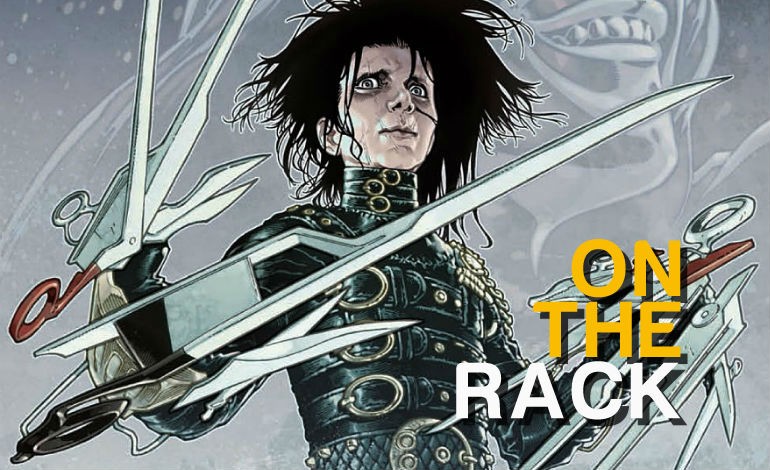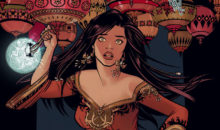On the Rack: Edward Scissorhands
Tim Burton’s style is almost impossible to replicate, so it’s to the credit of Kate Leth and Drew Rausch that they did not try to imitate him when they decided to give his classic Edward Scissorhands a comic sequel. Set fifty years after the movie, Edward’s story continues in this new ongoing series. The comic picks up the story from the 1990 film, with Edward back in the Inventor’s castle isolated and alone until he finds another one of the Inventor’s inventions who, like him, is missing something. In the meantime, Kim’s granddaughter Megs who is seen at the end of the movie, is on the hunt for the truth behind her late grandmother’s story. As a huge fan of the movie, I couldn’t have imagined a successful sequel, but it seems as though publisher IDW has found the formula.
Kate Leth is the comic’s writer, and she rises to the challenge of giving such a well-loved film a sequel. The story mirrors the movie in Edward’s quiet and well-meaning naiveté and Megs’ strong will and refusal to take things at face value. Johnny Depp’s portrayal of Edward is a large part of what made the movie so memorable, and Leth is able to channel the spirit of that performance successfully into a comic version. He is soft spoken and gentle, but also deliberate in his actions and contemplative. Unlike Edward, Megs doesn’t really appear in the movie except as a young girl listening to a story, but Leth fashions her after Winona Rider’s Kimberly, Megs’ grandmother. She is independent, curious and head strong. Having captured the spirit of the characters, Leth crafts a story that moves away from the original. This time instead of Edward being saved, this issue sees Edward discover another invention that needs his help.
To accompany Leth’s story, Drew Rausch illustrates the book. Like Leth, he strives to capture the spirit of Burton’s work without creating a copy. He is very successful at giving the book a uniquely quirky aesthetic that obviously draws inspiration from Burton’s own sketches. Beyond that, the characters are hyperbolic; they share Burton’s large round empty eyes, but instead of Burton’s signature lankiness, the characters all have their own exaggerated proportions. The color pallet sets the Inventor’s castle apart from the suburban homes below. As the book opens on Edward in the castle, the reader is caught in his world of black and white. Shades of grey and inky shadows add to his isolation. As you meet Megs, her world is bright and oversaturated. Fortunately, Rausch recreates the difference between the two worlds without duplicating Burton’s cookie cutter pastel homes from the movie. Rausch’s colour-filled suburban landscape is not only a more modern interpretation of Burton’s original concept, but also an effective contrast to Edward’s loneliness.
No one can capture the feeling of Burton’s Edward Scissorhands, that movie holds a place of honor in the pantheon of cult favourites for a reason. It has a whimsical, magical feeling that helps the viewer see through Edward’s eyes. This comic sequel is reminiscent of its cinematic predecessor without falling into the trap of imitation. It has its own offbeat charm in both the story and art, and finds its own voice in order to stand up to its predecessor. Fans of Burton’s classic will want to pick up this charming sequel which brings back just enough of the well-loved elements from the original, but also stands on its own two feet.










